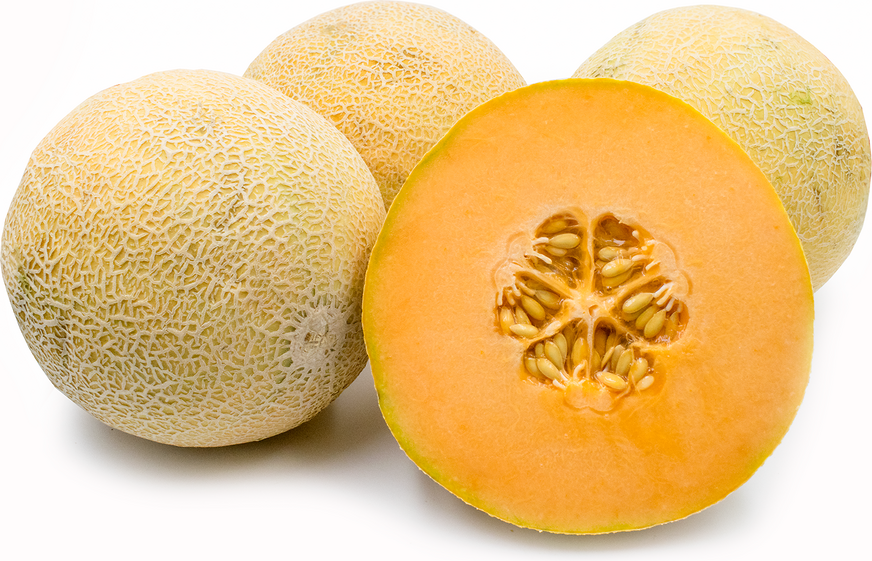


Origami Cantaloupe Melons
Estimated Inventory, ea : 0
Description/Taste
Origami melons are a small to medium-sized varietal, averaging 8 to 12 centimeters in diameter, and have a round to oval shape with a uniform, curved appearance. The melon's rind is thin, textured, and rough. When ripe, the surface transitions from green to a golden yellow hue and is covered in a raised tan netting. Underneath the surface, the dark orange flesh is thick, firm, and aqueous with a crisp, succulent consistency. The flesh also encases a small central cavity filled with tapered ivory seeds suspended in a gelatinous liquid with pale orange fibers. Origami melons release a robust floral, fruity, and musky aroma and should feel heavy for their size when ripe. The blossom end will also have a slight give when pressed. Origami melons have high sugar content, ranging from 8 to 16 Brix, and generally average between 16 to 18 Brix, while other commercial cantaloupe varieties are around 14 Brix. The high sugar content creates a sweet, sugary flavor with subtle floral and musky undertones.
Seasons/Availability
Origami cantaloupes are available in the late spring through fall.
Current Facts
Origami cantaloupes, botanically classified as Cucumis melo, are a modern variety belonging to the Cucurbitaceae family. The melons were developed in the United States in the early 21st century and were specifically designed as an improved commercial variety. Origami cantaloupes were bred to have extended storage capabilities, allowing the melons to be shipped long distances without compromising quality. The cantaloupes are also prized for their thin rind and sweet flavor and will naturally slip off of the vine when ripe, ensuring that the melons sold in stores are ready to eat. Origami melons arrive early in the season, and since their release, the variety has become one of the most popular commercial cantaloupes sold in the United States.
Nutritional Value
Origami cantaloupes are a source of fiber to regulate the digestive tract, vitamin A to maintain healthy organ functioning, and vitamin C to strengthen the immune system while reducing inflammation. The melons also provide calcium to build strong bones and teeth, potassium to balance fluid levels within the body, magnesium to control nerve functioning, and other nutrients, including folate, phosphorus, copper, and zinc.
Applications
Origami melons have a sweet, floral taste suited for fresh preparations. The melon's aromatic nature complements sweet and savory dishes, and its juicy flesh is savored when consumed straight out of hand. Origami melons can also be chopped into salads, mixed into salsas, stirred into fruit bowls, or used as an edible topping over parfaits, granola, and pancakes. Try combining sliced Origami melons with cucumbers or tomatoes as a refreshing summer salad. Origami melons also complement soft cheeses and nuts on charcuterie boards, filling the air surrounding the board with a sweet, musky, and floral aroma. The melon's succulent flesh is popularly wrapped in prosciutto as a salty-sweet appetizer, or it can be pureed into chilled soups. The melons can also be blended and frozen into smoothies, shakes, popsicles, sorbet, and ice cream. While less common, Origami melons can be thinly sliced and layered into fresh spring rolls, cooked as a topping on pizza, incorporated into custard, or used as a flavoring in baked goods and desserts. Origami melons pair well with cheeses such as feta, goat, and mozzarella, nuts including hazelnuts, almonds, and pine, herbs such as mint, basil, and cilantro, and fruits including citrus, berries, watermelon, pineapple, and stone fruits. Whole, unopened Origami melons will keep for 1 to 2 days at room temperature to ripen. Once mature, the melons should be immediately consumed for the best quality and flavor or kept in the fridge for 2 to 3 weeks. Sliced pieces of the flesh will keep 1 to 3 days when stored in a sealed container in the refrigerator.
Ethnic/Cultural Info
Around the time of the Origami cantaloupe's creation in the late 20th and early 21st centuries, the cantaloupe market declined due to inconsistency among commercially produced varieties. American growers were faced with choosing to grow flavorful melons with limited shipping abilities or varieties that could ship well but had little to no flavor. This created frustration across the cantaloupe market, and consumers switched to other types of melons, causing the sector to decline. Legends Produce, one of the largest cantaloupe suppliers in the United States, decided to partner with researchers and scientists to create an improved cantaloupe variety that mirrored the rich flavors found in heirloom cultivars but had the durability of modern melons. Before Origami cantaloupes, Impac cantaloupes were their number one commercial variety, but the cultivar suffered from having a short shelf life. After years of trialing and crossbreeding, Origami cantaloupes were created and embodied the consumer market's desires. The variety is flavorful, tender, has high Brix, a smaller seed cavity, and survives being shipped long distances. Origami cantaloupes have become Legends Produce's best-selling variety, and along with a few other cultivars, the company sells over 7 to 9 million boxes of cantaloupes each year.
Geography/History
Origami cantaloupes were developed by the Harris Moran Seed Company, now known as HM Clause, in the United States. The variety was traditionally crossbred to create a melon with the best qualities of the well-known cantaloupes of the late 20th and early 21st centuries, including Impac, Western Shipper, and Harper. Origami cantaloupes were produced from seed trials in 2004, and the seed company partnered with Legends Produce, a melon grower known for their cantaloupes. Legends Produce began with 300 acres of Origami cantaloupes, but soon after its release, the popularity of the variety led the company to expand production. Origami cantaloupes became the company's top variety, and currently, the melon accounts for sixty percent of the melons grown by Legends Produce. Origami cantaloupes are grown in Southern California, Central California, and Arizona and are sold through retailers, markets, and distributors across the United States.
Recipe Ideas
Recipes that include Origami Cantaloupe Melons. One




